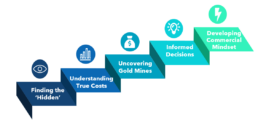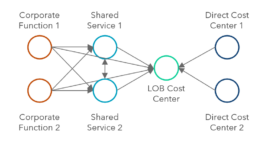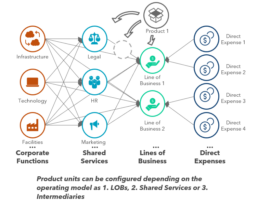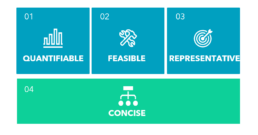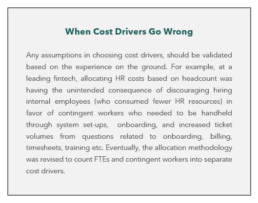Time to Start the Pivot
The near-to-medium term horizon is still riddled with uncertainty – of inflation, a potential recession, supply chain disruptions, new COVID variants, the future of crypto, and political conflicts.
In such an environment, a proactive effort to drive financial flexibility and transparency goes a long ways towards navigating the turmoil successfully. Achieving financial flexibility is dependent on having a transparent and repeatable process by which the incurred costs are automatically allocated to business functions who incur them.
There is often a negative connotation associated with cost optimization exercises. It is perceived to result in compromised quality of operations. However, looking under the hood of the cost engine to remove expenses on unnecessary items (unused subscriptions, underutilized cloud resources, etc.) and improving efficiency in shared functions (HR, legal, facilities, etc.) can significantly increase market competitiveness – critical for success in a period of slow economic growth.
Costs directly aligned to the products and services of a business, are easier to investigate and streamline. On the other hand, costs that are not directly aligned to the end services of a firm and have to be allocated to multiple entities before being assigned to their final cost center, often makes traceability, discovery and optimization difficult.
Setting up an efficient and comprehensive tracking and allocation system and making individual business units accountable for ‘all’ of their expenses, has significant benefits (see Exhibit 1).
Exhibit 1. Benefits of Transparency into Cost Allocations
- Finding the ‘Hidden’: The first benefit is the ability to track and measure all costs including traditionally hidden expenses.
- Understanding the ‘true’ costs of everything: The organization can create detailed P&Ls and scrutinize the true cost of running the business – down to individual product units.
- Uncovering gold mines: Firms can delineate the true gold mines from the money pits in their offerings. For example, after accounting for customer support costs a product once thought of as a success may not truly be as profitable.
- Informed Executive Decisions: True LOB performances can be established. Simple things, such as benchmarking (internally & externally) consumption across lines-of-business (LOBs) can be very informative. This equips business leaders with the tools to make decisions informed by their impact on future profits.
- Developing a Commercial mindset: Shared services are inspired to be competitive since their costs can new be benchmarked versus industry leaders. Simultaneously it incentivizes conscious consumption of services by the LOBs.
Designing the Cost Engine
Where should you start to look for inefficiencies in the existing process of recording and allocating costs?
What is the point of diminishing returns, when fine tuning the cost allocation process?
Finding the right cost flow structure often requires artfully balancing simplicity versus accuracy. A simplistic cost flow may take a more communal approximation to allocations, making it easier to develop and maintain. This works well for smaller, agile organizations, who don’t need to track every resource utilized.
Conversely, maintaining high precision in cost allocations promotes a culture of accountability as each LOB has to pay for their exact resource utilization. It also provides a clear view into the best opportunities to optimize costs. However, it requires greater maintenance, and often has the unintended consequence of leaders only focusing on the largest line items. Tracking all expenses in detail may create bureaucratic red tape, slowing down or impeding day-to-day operations.
The ideal way to strike the right balance is to start from the source and move to the receiver, i.e., first secure the buy-in from the entity providing the service to the entity consuming the service.
Exhibit 2. Developing Cost Flows
Revisiting cost centers
The next step in the puzzle is to create the right hierarchy of the cost centers enabling different levels of summarization without compromising on the granularity of cost components.
Eventually, there are four types of cost centers:
Exhibit 3. Financial Services Add-Ons
Exhibit 4. Types of Cost Centers
Customizing the solution for your need
The target flow of costs in the organization is not a one-size-fits-all solution. The allocations and flows need to be tailored to accurately reflect the operating model. Besides, the system needs to be adaptable to potential changes in the operating model and strategic goals of the organization.
The four types of cost centers are also not ideal for all situations. For example, if the LOBs have distinct product offerings, then product cost centers can be re-purposed as LOB cost centers. On the other hand, if the same products are sold by multiple LOBs across geographies or channels, then products are typically used as a shared service.
However, in the later situation, tweaking the standard cost structures can provide a more elegant, accurate and representative solution. Product cost centers can form an additional layer in between shared service and LOB cost centers. This ensures that the product groups are accountable for their consumption of shared services (HR, finances, marketing, etc.) and that their costs are not forgotten.
At the same time, it helps other shared service entities to provide a more accurate value for their expenses as the services rendered towards the product groups are also accounted for.
Exhibit 5. Cost Center Configurations for Products
Looking Beyond ABC
Once the cost center hierarchy is designed and the allocation flow is established, the next step is to finalize the approach for sending costs through the flow. Usually activity-based costing (ABC) is the go-to approach in the industry. The allocations are dependent on the actual consumption of a service, and hence, this approach ensures an equitable distribution of costs and incentivizes efficient consumption.
However, this approach is not always suitable, and in many cases, not even feasible. Alternate approaches may be better in increasing cost efficiency and transparency.
-
Actuals Based Allocation:
When the actual costs incurred by a business unit can be quantified, the individual cost centers need to be designed so they can be tied to a particular LOB, which eliminates the need for cost allocation. For example, if a LOB builds an application customized for their services, it does not need to be clubbed with the generic app development cost centers before reallocating based on development hours. In this case, creating a separate cost center for the special project leads to easier cost management.
Tech integration often eliminates the need for allocation. For example, if the legal ticketing system can be connected to the financial reporting system, the actual legal expenses for each LOB can be directly assigned as opposed to implementing activity-based pricing.
-
Proportion Based Allocation:
Spending significant money and resources to manage a long list of cost drivers may not be the most cost-effective solution. For example, in many service-driven functions, neither finding actual costs nor modelling consumption may be viable.
In such cases, a heuristic driven proxy (e.g., annual revenue) needs to be used to determine an equitable split to each assignee. Since this approach abstracts out the nuances and has lighter data requirements, it is easier to implement.
-
Fixed Allocation:
Some expenses, such as, enterprise software subscriptions are consumption agnostic. In such cases, the fixed expenses of this ‘all you can eat’ model are allocated to all relevant business units. This is especially useful to promote adoption of a new solution. However, caution must be exercised for enterprise license charges that are based on usage tiers.
Choosing the Right Cost Driver
In any financial reporting systems, majority of cost allocations continue to be based on activity-based costing. In this method, choosing the most appropriate driver of costs is key to fair and equitable cost allocations.
Common questions when choosing the driver include:
-How do the various options compare?
-How to decide if there are incremental returns in addition of a new driver as compared to the additional maintenance costs?
There are four considerations while selecting a cost driver:
Exhibit 6. Identifying Cost Drivers For A Cost Center
-
Quantifiable:
Perhaps the most obvious parameter of a cost driver is that it must be tangible and quantifiable. Calculating the split of costs downstream requires dealing with well-defined quantities. Abstract concepts such as organizational benefit and utility need to be translated into tangible factors e.g., headcount, incremental revenue and number of products sold.
-
Representative:
To ensure an equitable allocation, it is key that the cost-driver is a good proxy for the cost-center expenses. For example, facilities expenses should be driven out using location-wise headcount, instead of overall employees per LOB across geographies. This ensures LOBs in cheaper locations are not subsidizing LOBs operating in expensive venues. Finding a representative cost-driver becomes more challenging for shared corporate services such as HR, Finance and Legal, where it is difficult to identify a proxy for tracking utilization.
-
Feasible:
Several metrics that seem representative, might be difficult to track. Trade-offs between being representative and feasible to implement are commonplace. For example, while allocating out facilities expenses based on square footage (thus charging for larger offices) may seem appropriate, it may not be feasible. Instead, using a headcount driven approach makes more sense.
-
Concise:
While selecting cost drivers, it is always desirable to reuse, where possible. For example, when allocating real estate charges, it may at times be tempting to charge out based on number of parking bays, office cabins per LOB, stationery utilization etc. However, the value of each additional driver should be questioned.
Future-proofing cost driversAs business needs change and internal org changes take place, established allocation methods will require updating. By selecting quantifiable, representative and feasible drivers, the drivers may not need to. One of the qualities of the ideal driver is it is adaptable to the changes brought on by time.
Exhibit 7.
In Closing...
Given the uncertainty in the current global political and economic climate, achieving financial flexibility goes a long way in future-proofing the business. Organizations need to have a transparent and streamlined process to track, categorize and allocate all expenses. This always promotes cautious consumption of resources and services across the organization.
Determining the best cost driver for these cost allocations is key to getting the cost flows and profitability estimates correctly. With such reliable transparency, business owners can take accountability and be motivated to minimize wastage. Unnecessary expenses can no longer be hidden in common pools at an enterprise-level. Financial flexibility can have a meaningful impact on the bottom line and prepare the organization for whatever the future may bring.
__________________________________________________________________________________________________________
